Building a stronger bench is often at the top of every powerlifting and strength athlete. When looking at isolating weaknesses in the bench press, lifters can break down the individual angles and muscle groups that may be responsible for staggered success.
Using partial reps, pauses, and pin presses can all increase muscle development and force output of stagnant muscles and boost performance. In this article, we will go through everything you need to know about the pin press, including:
- Pin Press Form and Technique
- Benefits of the Pin Press
- Muscles Worked by the Pin Press
- Who Should Do the Pin Press
- Pin Press Sets, Reps, and Programming Recommendations
- Pin Press Variations and Alternatives
How to Perform the Pin Press: Step-By-Step Guide
Below is a step-by-step guide on how to perform the pin press using the bench press variations. Further below we will discuss a wide variety of variations and alternatives to the pin press.
It is important to note that the pin press can also be done using the overhead press, with similar benefits of strength and mass for the shoulders and triceps (instead of the chest and triceps).
Step 1. Set the Pins
Start by setting the pin height to correspond with the specific range of motion you are attempting to train. The higher the pins, the greater emphasis on lockout and triceps strength. Once you have set the pins, perform some warm up sets to ensure proper positioning.
Coach’s Tip: Place the pin height just below or at your sticking point to address strength-specific weaknesses in the press.
Step 2. Unrack and Descend
Similar to the bench press, unrack the weight using the same setup and unracking procedure you would in the bench press. Once you have secured the weight above the shoulders and chest, lower the load under control, making sure to keep the elbows in and back set.
Do not drop onto the pins/supports, but rather lower the load with control. Additionally, at the bottom of the press, your back should be tense and there should be no slack in the system.
Coach’s Tip: Do not lose tension at the bottom of the movement.
Step 3. Press and Repeat
Once you have hit the pins, press upwards into the barbell to lift the load. Complete the repetition similarly to how you would lockout a bench press.
Coach’s Tip: Keep the back set and press through the barbell.
3 Benefits of the Pin Press
Below are three (3) reasons why the pin press is beneficial for lifters and athletes of all types.
1. Improved Triceps Strength and Hypertrophy
The pin press specifically attacks the triceps as the range of motion places greater demands upon the elbow extension aspect of the movement. For lifters looking to increase triceps strength and hypertrophy or have issues locking out a press, the pin press can be a great movement to add to their strength and accessory lifts.
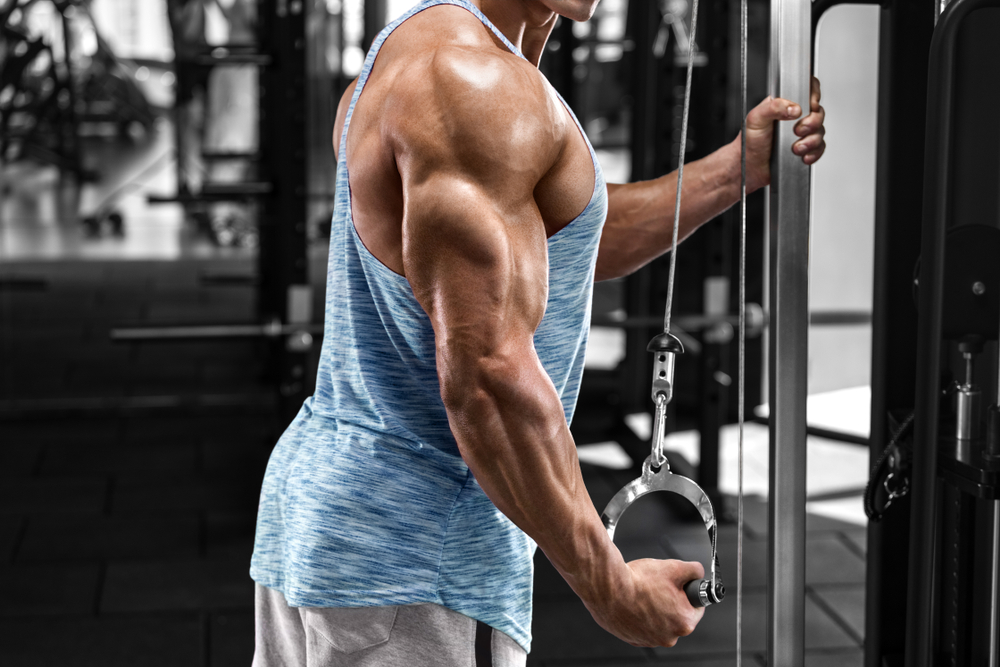
2. Attack Sticking Points
The pin press allows a lifter to attack a sticking point at the exact range of motion the limitation of strength is present. Strength is angular specific, meaning that lifters need to address a sticking point by training the exact range of motion it occurs at. The pin press allows us to do that.
3. Overload Pressing Movements
The decreased range of motion often results in a lifter being able to perform receptions with greater loads, helping to increase overall strength and mass. When used in conjunction with full range movements, the pin press can be a valuable overloading tool to boost strength and muscle development.
Muscles Worked – Pin Press
The below muscles groups are trained during the bench press pin press variation. The lower the pins, the more pectorals are active in the movement.

- Triceps
- Pectorals
- Scapular Stabilizers
- Shoulders
Who Should Perform the Pin Press?
Below are a few groups of athletes that can benefit from including pin presses within their training programs.
Strength and Power Athletes
Bench press performance and overall pressing strength is essential for strongman and powerlifting athletes. Improving lockout performance and addressing sticking points in the bench press can add pounds to a lifting total and ultimately have a significant impact on sports performance.
Olympic weightlifters can also use the pin press to address any limitations in triceps strength and mass and improve general upper body strength. The pin press can also be used to limit shoulder stress during pressing movements, something that is always important for weightlifters, powerlifting, and strongman athletes alike.
Competitive CrossFit and Fitness Athletes
While the bench press is not typically a sport-specific movement in most WODs and competitions, CrossFit and functional fitness athletes can benefit from including the pin press within accessory or strength programs to improve lockout strength and muscular development.
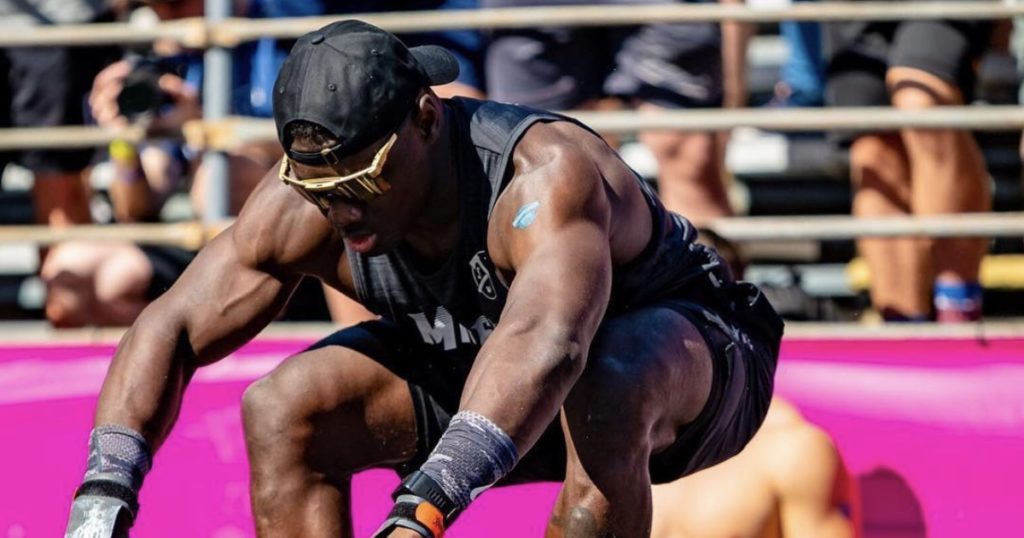
Movements like push presses, weight lifting, and handstand push ups all require increased triceps and pressing strength, making the pin press another tool to be used to continually progress performance.
Sports Athletes
The triceps are often a key muscle group necessary for contact sports. Using the pin press, coaches can increase general pressing strength, increase triceps mass, and add upper body explosiveness; all while decreasing shoulder stress (assuming proper technique and limited deep shoulder horizontal abduction).
General Fitness and Desk Bound Individuals
For general fitness goers and deskbound athletes, bench press variation like the pin press (and floor press, see below) are two movements that can be done to limit shoulder stress while still adding upper body strength. Additionally, the need to control the load at the bottom of the press (rather than let the bar bounce off the body and/or sink into the body) results in the lifter needing to express both stability and coordination at deep ranges of horizontal shoulder abduction.
Using the pin press can not only develop strength and hypertrophy of the triceps and pectorals, it can also improve bench press technique, muscle coordination, and stability necessary for heavier and more advanced pressing training.
Pin Press Sets, Reps, and Weight Recommendations
Below are three (3) primary sets, reps, and weight (intensity) recommendations for coaches and athletes to properly program the pin press specific to their training goals. Note, that the below guidelines are simply here to offer coaches and athletes loose recommendations for programming.

Muscle Hypertrophy – Reps, Sets, and Weight Recommendations
- 4-5 sets of 8-12 reps with moderate to heavy loads to increase muscle hypertrophy of the triceps and pectoral muscles
- Maintain tension at the bottom of the pin press to increase muscular demands.
Strength Reps, Sets, and Weight Recommendations
- Training the pin press similarly to bench press strength protocols can occur.
- Many lifters will find that they can handle heavier loads relative to their 1RM for bench press due to the limited range of motion.
Power Reps, Sets, and Weight Recommendations
- Perform 4-6 sets of 2-3 repetitions with moderate loads, emphasizing maximal power and explosiveness off the pins.
2 Pin Press Variations
Below are two (2) pin press variations to build upper body strength and hypertrophy and improve scapular stability.
1. Accommodating Resistance Pin Press with
Attaching chains and bands to the pin press is a great way to increase the rate of force production, increase additional overloading stress, and develop higher recruitment rates of the triceps and chest. Simply add some chains or bands of the pin press and get pressing!
2. Pin Press Bench Throws
This plyometric pin press variation requires a Smith machine, pins, and a spotter (although not 100% necessary if you have a Smith machine and pins set at the correct height). To do this, load the bar with roughly 40-60% of your max and perform pin press throws; allowing the bar to get tossed vertically along the tracks. Meet the barbell and control it eccentrically and repeat.
Like accommodating resistance, this can help increase the rate of force production and explosive power, however adding in the throw takes this movement to the next level. Be sure to start with light loads and use a spotter. Additionally, be sure to set the pin heights higher than chest level.
3 Pin Press Alternatives
Below are three (3 ) pin press alternatives that can be used to improve upper body strength and hypertrophy.
1. Floor Press
The floor press is a pin press alternative that uses the floor rather than pins to restrict the range of motion. This is a good swap for lifters who may not have access to a standard power rack yet are looking for many of the same triceps strength and mass benefits of the pin press
Floor Press Guide
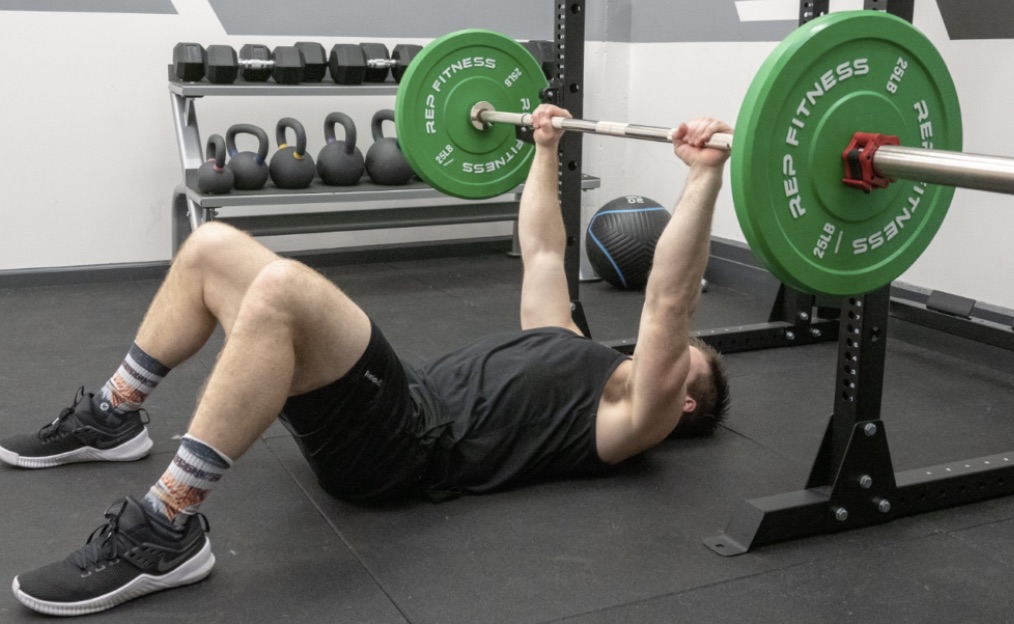
1.
Setup Underneath the Barbell
Start by positioning yourself on the floor underneath the barbell (eyes should be underneath). With the legs either straight or bent, be sure to place the feet, hips, and upper back on the floor, similar to that of a bench press.
Note, that this relationship with the floor is essential to the floor press. Often, individuals who struggle with this on a bench may find it easier to develop greater back tension in the floor press in the early learning phases.
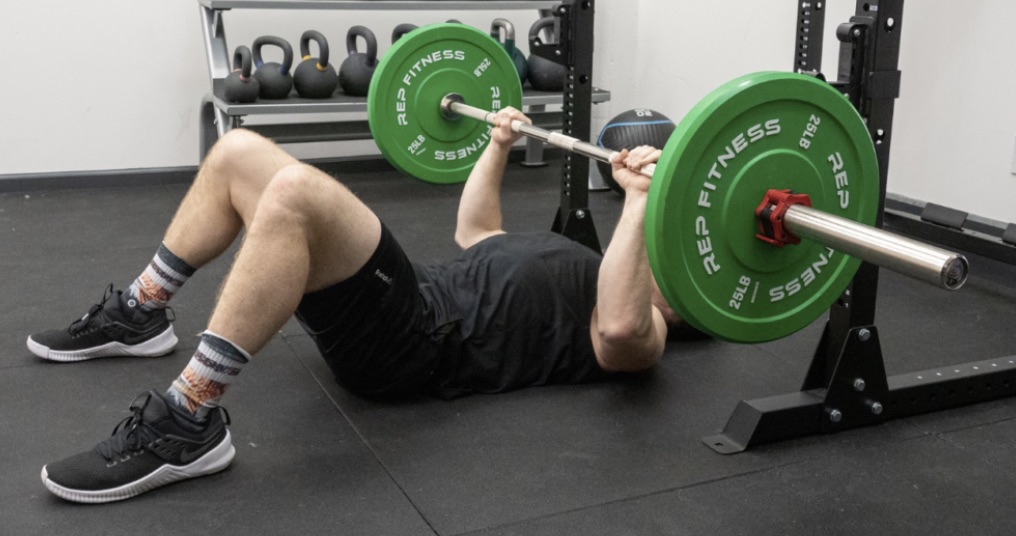
2.
Grip the Floor, Bring Elbows Downwards
With the body actively gripping the floor, firmly squeeze the barbell and pull the elbows down towards the torso, on a slight angle to ensure that the back muscles and posterior shoulders are being activated.
Be sure to pull the barbell to the base of the chest (just above the sternum) so that the elbows are roughly 45 degrees from the torso.
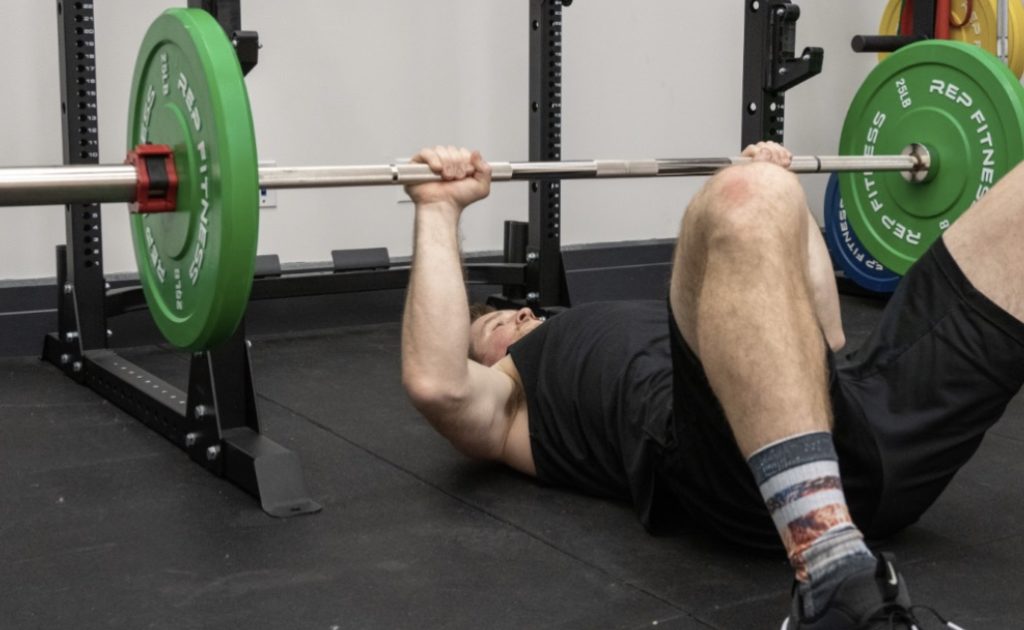
3.
Gently Contact the Floor, Then Press
Once you have gently made contact with the back of the elbows to the floor, remain in tension and reverse the movement so that you go into the concentric pressing phase of the floor press.
Note, that lifters can pause at the bottom of the press (which I prefer) to help increase stability, control, and gain a deeper understanding on how to develop and maintain tension and strength throughout the full lift.
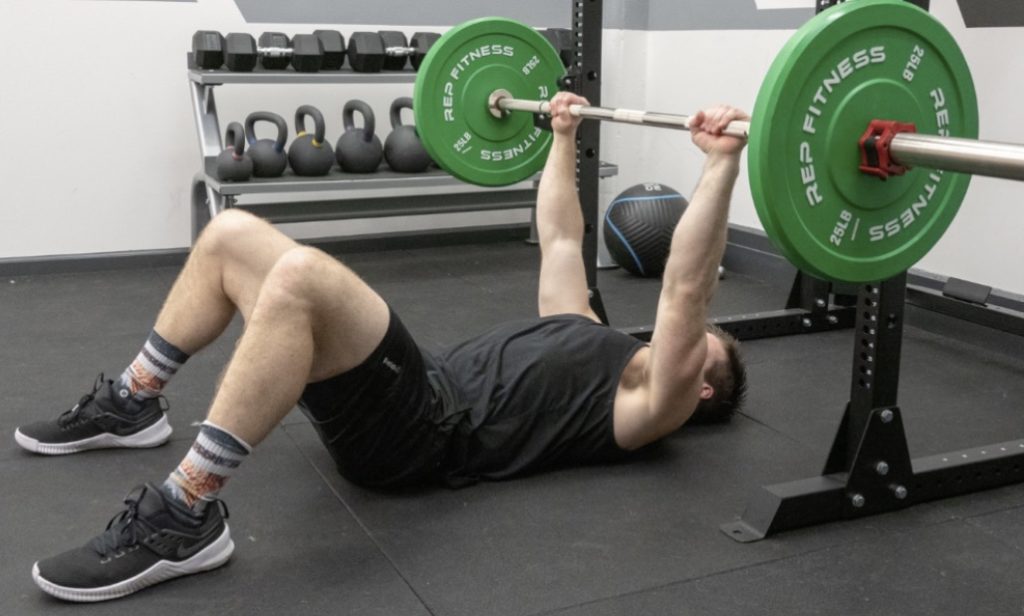
4.
Lock Out, Prep for Next Rep
Once you have returned to the top of the movement, repeat for the prescribed repetitions, rest, and repeat.
Make sure to not over protract at the top when completing a rep, as this could throw your positioning and base out of line.
2. Board Press
The board press is nearly identical to the pin press, however rather than setting the bar on pins at the bottom of the press, the lifter stops the barbell on a board that is resting on their chest. Depending on the thickness of the board, the lifter can shift emphasis on the triceps, chest, or various ranges of the movement.
3. Partial Pause Press
The partial bench press is another pin press alternative lifters can use to restrict the range of motion to isolate specific areas at which they are weaker. Adding in a brief pause at the bottom of the movement can increase time under tension and reinforce stability and control at the bottom of the press.